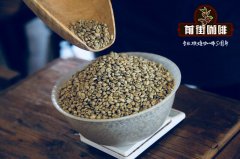Description of taste and flavor of Ethiopian coffee beans after sun treatment in Xidamo Valley.

Professional coffee knowledge exchange more coffee bean information please follow the coffee workshop (Wechat official account cafe_style)
Qianjie boutique coffee recommendation | Yega Chuefei Sun Red Cherry | Costa Rican Shumawa Black Honey | Costa Rican Angel Manor
Ethiopia sun Xidamo G1 Valley Geji producing area Korsha
(Ethiopia Guji Kercha Natural G1)
Flavor description: meticulous blueberry aroma and rich fruit flavor
Ripe oranges and grapes with a typical Sidamo rich coffee sweetness
Yu Yunjia is sweet and far away.
Country Ethiopia (Ethiopia)
Producing area Oromia Region
Guji (Guji Zone)
Producer: local coffee farmers in Kercha, Guji producing area
1900 to 2,000m above sea level
Variety Ethiopian Guyou original species (Heirloom)
Annual rainfall of about 1500 to 2, 000 mm (mm)
Soil: reddish brown
Treatment method African scaffolding sun drying treatment
Introduction:
The administrative region of Ethiopia is divided into four grades, the order from large to small is Region,
Zone, woreda, kebele, most of the place names of raw coffee bean producing areas follow this.
According to the rules of naming, the Guji producing area launched in this batch is located in the southeast of Yejia Sheffield, a well-known producing area.
The raw coffee beans belonging to Oromia Region → Guji Zone belong to the regional type in the division of administrative regions.
Just as Yejia Sheffield became well-known after becoming famous, it became the wide area Sidamo.
Independent secondary area Guji (Guji Zone). Guji producing area is in Sidamo province in recent years.
It is more beloved by buyers.
Guji Zone has always been a production area worthy of considerable attention.
The development in recent years has also confirmed that the rise of Guji producing areas is indeed the development of Ethiopia in recent years.
One of the important trends. In addition to beans from larger producing areas, such as Humbela, Shaquiso, etc.
There are also excellent beans from a processing plant or even a single manor, which is a traditional Yega Xuefei producing area.
Beyond the reach of others. What's more, in terms of innovative treatments, there will be batches of honey treatment.
In addition to the recent focus of Gesha Village, the Guoji producing area has also become
An important hot spot. To understand the trends in Ethiopia, Guji can be said to be non-negligible.
Highlight. Kercha is located in a tribal village in the Guji Zone producing area.
Farmers in natural villages mainly grow coffee and other small crops to earn a living.
The Kercha cooperative, which combines the families of small coffee farmers, will have
In the treatment field, the service is naturally dominated by members of local coffee farmers.
Guji Zone has always been a popular sponsor of the Dutch Red Cherry Project.
One of the key points. As a result of the exchange of information, the production technology of this area has naturally benefited and improved.
The Red Cherry Project (Operation Cherry Red) is the Trabocca of the Netherlands
It is dominated by the company, and half of the funding is funded by the Dutch government. Since 2005
Trabocca of the Netherlands cooperates with many small coffee cooperatives in Ethiopia
Teach and help encourage small coffee farmers to improve post-processing techniques starting from the harvest of red fruits
Such as washing, sun or fermentation treatment to improve the quality management of coffee. Whenever in the harvest season
Trabocca will invite selected coffee farmers' organizations and producers to participate in the project.
Collect micro-batches of coffee (about 1500 to 3, 000 kilograms) and select them by hand in batches
100% ripe red coffee cherries (so called the Red Cherry Project). Finance provided by Trabocca,
Resources such as equipment and technology assist farmers and promise to actually follow the standard process (SOP) output.
The quality of the specifications up to the required standards will be purchased at an excellent price. The spirit of the plan
It's kind of like a contract.
Qianjie coffee: Guangzhou bakery, the store is small but a variety of beans, you can find a variety of unknown beans, but also provide online store services. Https://shop104210103.taobao.com
Important Notice :
前街咖啡 FrontStreet Coffee has moved to new addredd:
FrontStreet Coffee Address: 315,Donghua East Road,GuangZhou
Tel:020 38364473
- Prev

Yegashefi G1| Koke Station| Honey treated coffee beans
Professional coffee knowledge exchange More coffee bean information Please pay attention to coffee workshop (Weixin Official Accounts cafe_style) Qianjie boutique coffee recommendation| Yega Shefi Sun-dried Red Cherry| Costa Rican Shumava Black Honey| Costa Rica Angel Manor Ethiopia Yirgacheffe Koke Honey G1
- Next

Zimbabwe Coffee Bean | Zimbabwe Coffee | South African Coffee | alimba Manor
Professional coffee knowledge exchange more coffee bean information please follow the coffee workshop (Wechat official account cafe_style) front street boutique coffee recommended | Guatemala Polsa Pacamara Zimbabwe coffee beans in the player circle belongs to the African bean must taste, the bean is beautiful, sour and sweet with a very rich and dry taste: caramel, nutty, oil, sweet spices, grass root
Related
- Does Rose Summer choose Blue, Green or Red? Detailed explanation of Rose Summer Coffee plots and Classification in Panamanian Jade Manor
- What is the difference between the origin, producing area, processing plant, cooperative and manor of coffee beans?
- How fine does the espresso powder fit? how to grind the espresso?
- Sca coffee roasting degree color card coffee roasting degree 8 roasting color values what do you mean?
- The practice of lattes: how to make lattes at home
- Introduction to Indonesian Fine Coffee beans-- Java Coffee producing area of Indonesian Arabica Coffee
- How much will the flavor of light and medium roasted rose summer be expressed? What baking level is rose summer suitable for?
- Introduction to the characteristics of washing, sun-drying or wet-planing coffee commonly used in Mantenin, Indonesia
- Price characteristics of Arabica Coffee Bean Starbucks introduction to Manning Coffee Bean Taste producing area Variety Manor
- What is the authentic Yega flavor? What are the flavor characteristics of the really excellent Yejasuffi coffee beans?

